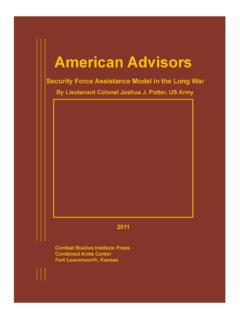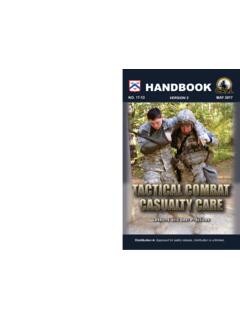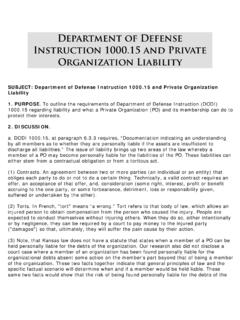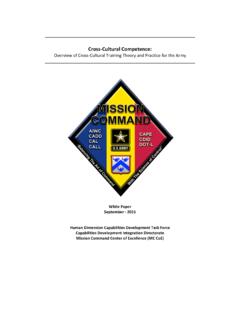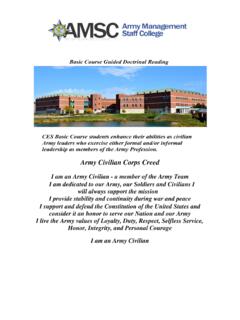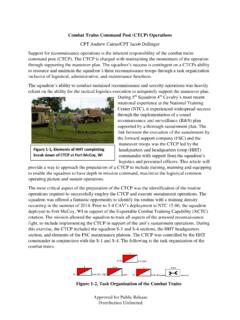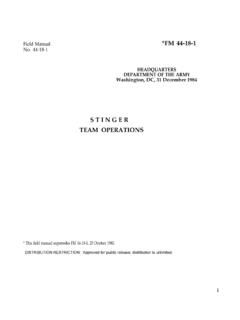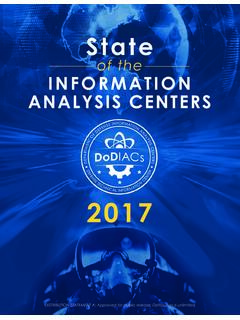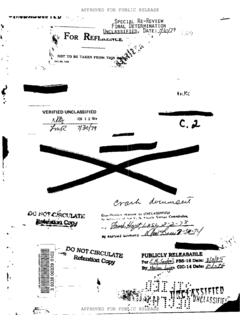Transcription of DISTRIBUTION RESTRICTION: Approved for public release ...
1 FM 34-81/AFM 105-4 CHAPTER 1 WEATHER SUPPORT FOR THE AIRLAND BATTLEW eather is critical to Army tactical operations and operational is filled with examples of the weather s effects oncombat operations on a variety of AirLand battlefield oftoday may provide additional examples of victories and defeats attributableto skillful integration of weather in military planning and execution ofcombat ,enemy, and terrain are often referred to asthe wet trilogy, as shown in Figure information is as much a part of combat intelligence as enemyand terrain is often as significant as enemy intentions andIt affects enemy actions and the decisions of bothweather Affect mobility.
2 Decrease the ability to see and attack deep. Degrade electro-optical (E-O) systems. Increase the requirement for thoroughly integrated air and groundoperations. Slow the movement of supplies and is one dynamic factor on the battlefield which commanderscannot control but which has the potential to affect every combatant, pieceof equipment,and becomes more significant to1-1FM 31-81/AFM 105-04success on the Air Land battlefield as advanced E-O weapon systems arefielded because of their vulnerability to adverse must be aware of and prepare for general and specificeffects of weather on enemy and friendly major weapons systems includes evaluating plans to minimize the adverseweather effects on friendly forces and to maximize the effects on adversaries do not place as much emphasis on numericalweather prediction as the United States and its North Atlantic TreatyOrganization (NATO)
3 Pact doctrine minimizes the effects ofchanging weather conditions by seizing and holding the initiative throughspeed, mass,and and accurate weather forecasts helpour commanders exploit this Warsaw Pact a low-intensityconflict (LIC),the enemy will most likely have very primitive support to US forces allows commanders to employtheir forces to maximum effectiveness according to the major tenets of theAirLand Battle. Initative. Adverse weather normally favors the ,changing conditions provide both sides with windows ofopportunity and use these windows toset the terms of battle, defeat the enemy attack, and seize use these windows to enhance the attackand carry the battle to conclusion.
4 Depth. As the battlefield is extended in space and time itbecomes more likely that weather conditions will vary, openingwindows of opportunity and vulnerability. Agility. If commanders are knowledgeable of weather effects onthe enemy and friendly forces,then timely and accurate weathersupport will enable them to respond to changing conditions morerapidly than the enemy. Synchronization. The combat power of AirLand Battle forces ismade up of many components,each with its own unique order to employ these component forces formaximum effect on the battlefield,commanders must know of weatherconditions and weather effects on the BATTLEThe AirLand Battle is an extended,integrated battle involving the useof all available air and land is extended because the battleis fought from the rear boundary out to the range of available weapons asa single.
5 Continuous is integrated in that nuclear and1-2FM 34-81/AFM 105-4chemical weapons are merged with electronic and conventional weapons inall operations and use of nuclear and chemical weapons dependson the tactical situation and requires a release from the national in the AirLand Battle is the simultaneous fighting of deep,close-in,and rear need for deep attack emerges from thenature of our potential enemy s doctrine and numerical are to-- Gain a degree of manipulative control over enemy follow-on enemy combat power before they can join in the close-inoperations in the the battle to the enemy s depth through bold but calculatedoffensive the enemy is doctrinally echeloned is not critical.
6 What isimportant is that superiority in numbers permits the enemy to keep asignificant portion of its force out of the fight, with freedom toeither overwhelm or to bypass the friendly existence of thesefollow-on echelons gives the enemy an advantage which must be forces must seize and retain the initiative in order to fightsuccessfully and gain the initiative, friendly forces must-- See deep and begin early to disrupt, delay, and destroy enemyfollow-on or reinforcing quickly against enemy assault echelons to prevent them fromachieving their the opening fight against assault echelons rapidly and goon the attack before follow-on echelons can join the battle.
7 Prevent enemy forces from reinforcing the assault forces andachieving their objectives through mass and continuous the opportunity to seize the initiative--to attack anddestroy the integrity of the enemy operations plan, forcing theenemy to stop the attack or risk are inherently created asthe enemy organizes forcesinto echelons that are needed for same vulnerabilitiesgive us the opportunity to put enemy second-echelon forces at great preparation of the battlefield (IPB) and target valueanalysis (TVA) help us identify high-value targets (HVTs).These targetsinclude bridges and choke points that cause enemy follow-on echelons to1-3FM 34-81/AFM 105-04bunch up and present lucrative deep attack providesthe friendly force commander the opportunity to seize the initiative anddictate battle strike and acquisition means are applied in a well-organizedand coordinated scheme to support this commander decides whento use deep attack and which targets to destroy to create opportunitiesfor offensive decision is based on a single scheme ofmaneuver and a fire plan for deep opportunities fordecisive action must be created in areas where sufficient
8 Logisticsupport, fire support,and maneuver forces are coordination of present and future action throughout the depthof the battlefield requires the plan come from one commander s of close and deep operations invites the risk thatopportunities will not be generated or, if generated, that forces will beunprepared to identify and exploit of command is essential to the extended battlefield. Thecommander is fighting one battle,composed of several parts, that depth of this battlefield extends beyond the forwardline of own troops (FLOT) and is a function of the commander's level of command has a dual responsibility.
9 Each commandermust attack the enemy s assault echelons and delay and disrupt follow-onechelons to seize the initiative and destroy their operational must also see and determine the intentions of enemy forces thatcan affect future AREAC ommanders consider the battlefield in terms of the time and spacenecessary to defeat the enemy force or to complete the assigned is the first consideration and must be related to a battlefield areaso commanders can direct their reconnaissance, surveillance, and targetacquisition resources to identify targets and convert timeinto space, commanders must consider the unit s mission and capabilitiesand the maneuverability, terrain,and capabilities of the view the battlefield as having two distinct areas which can beexpressed in terms of are the area of operations (AO) and thearea of interest (AI).
10 Weather products,like any other intelligenceinformation,must be keyed to those two AO is a geographical area assigned to commanders for which theyhave responsibility and in which they have authority to conduct are assigned an AO based on the mission, enemy,terrain,troops, and time available (METT-T).The AO is of sufficientsize to allow maneuver for successful completion of the mission, as shownin Figure 34-811 AFM 105-4 The AI is an area of concern to the commander. It encompassesadjacent areas and areas occupied by enemy forces that could jeopardizethe time span,as shown in Figure 1-3, is increased to allowplanning for future 34-81/AFM 105-04 Whether attacking or defending, each echelon of command must createthe time and space needed for subordinate echelons to defeat enemy forcesin contact before it becomes necessary to engage those not yet is done by attacking deeper enemy echelons to delay,disrupt, and destroy them before they can affect the operations offriendly subordinates.
